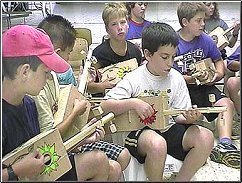MENU - INDEX - HOME
Principles
![]() General
General
Teaching in a group
I. Holding Positions
1. Sitting position
2. Ancient Guitar Position
3. Left Hand
a) Placing the hand
b) Mark
and Press
4. Right Hand
5. The plectrum
II. Playing
General
1.Contents of playing
a) Open string
b) Open string
and 1
c) Open string
+ 1 + 2
2. Music Creativity
General
a) Composing
b)
Improvisation
c) Solo
playing
III. Music pieces
IV. Two strings
1. General
2. The pieces
The New Music Educational Project - My Ancient Guitar
See our Videos... |
Principles
of playing How we will learn to play an Ancient Guitar |
General
Learning the holding positions will last from about three weeks to a month.
After the students have acquired the principles it will be necessary to review these
positions and improve them using the material played. Teaching the principles will not
constitute the whole lesson but only about one third of the lesson. The rest of the lesson
will include the experience of playing in pairs or groups of three, and each lesson will
end with orchestral playing. You can prepare simple material in order to make
sure this is a successful experience for all students.
This booklet, 'Play Ancient Guitar' offers plenty of material, and since it will not be possible
to review all of it, every user will adapt the material for his class/course.
Teaching the principles is sometimes considered to be a problematic stage, because we have
just finished the exciting building stage, but we do not really know how to play, and
learning requires work, patience and cooperation, which students sometimes lack. Therefore
we should prepare a number of pieces which may bring pleasure (and motivation).
The formula is to offer very simple pieces with accompaniment (or playback).
'Play Ancient Guitar'
will offer many pieces, but the teacher must be capable of writing some material for his
class on his own.

